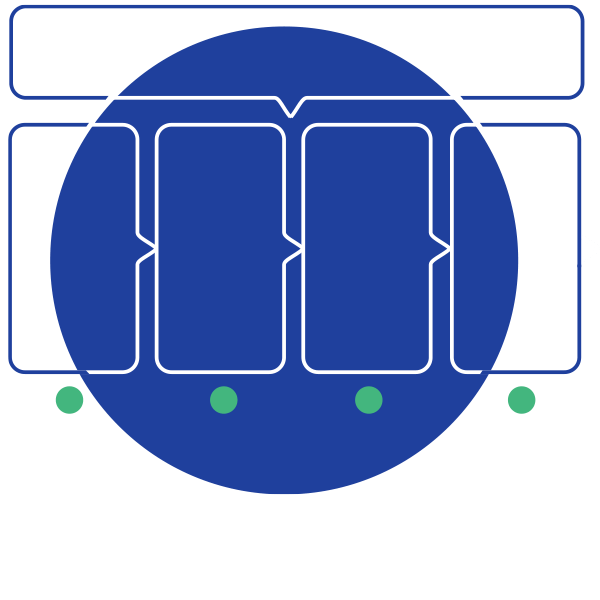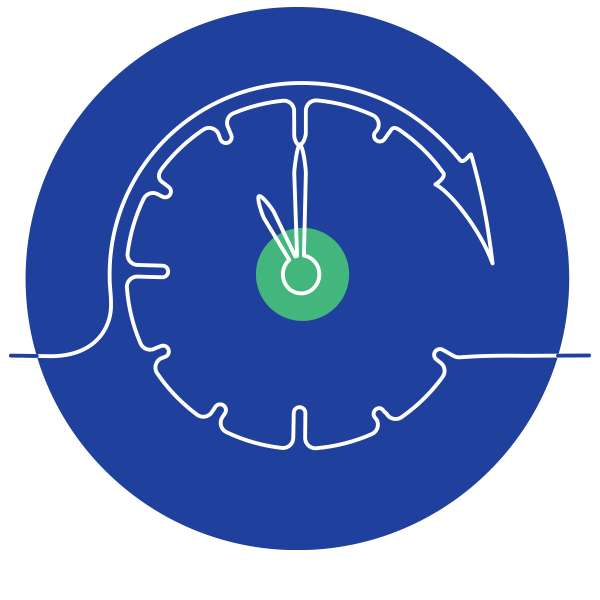Goals
These are a broad statement of the purpose of an initiative. They may take several years to achieve.
The following activities are necessary to measure performance and evaluate inclusive transportation planning efforts.
Let’s look at each one in more detail.

One of the keys to evaluation is to see it as a continuous process that begins before new inclusive transportation planning efforts start. It is therefore useful to collect baseline data as you begin. This is how you will know where exactly you are starting. Visit the Start section, above, of the toolkit webpage for details about this critical step.

An inclusive strategic planning approach starts with setting goals, establishing objectives, deciding what performance to measure, collecting existing data, and determining the activities to conduct based on the collectively identified goals and objectives. Put in place a strategic plan that can be occasionally revised and that will set your inclusive transportation-planning project in a realistic and achievable direction. Involving participants and partners will enhance your ability to communicate about your work.
These are a broad statement of the purpose of an initiative. They may take several years to achieve.
These are incremental signs of progress towards the established goal. Make sure that objectives are specific and measurable. Measurable means that quantitative measures of progress in achieving the objective can be established. For example, measuring the percentage increase in the number of participants actively involved in inclusive transportation planning is a typical quantitative measure of progress. Qualitative measures such as measures of participant or partner satisfaction may also be acceptable, but should be summarized so results can be reported as a number, for example the percentage of participants who indicated a process was inclusive.
These answer the question, what will we do? Activities must align with the identified goals and objectives and must be realistic given the resources available (funding, staff, volunteers). The desire to change the world can often lead to unreasonable expectations, so an occasional reality check during the process is useful.
What resources are being used? Inputs identify the funding, staff resources, volunteers and in-kind resources used to as part of the inclusive coordinated transportation-planning project.
What will the activities produce? Typical outputs for inclusive transportation planning projects include the number of participants serving on advisory committees, number of partnering organizations and number of planning meetings held.
Provide numerical information documenting progress towards achieving project objectives and goals. The key question with an outcome is, how will conditions change as a result of the activities we are conducting? The link between program activities and outcomes observed can be complex and may be influenced by many things, so it is important to understand these linkages and to be realistic about the extent to which activities are responsible for changes being observed. Outcomes specific to inclusive planning practices include the number of participants assuming leadership roles, the percentage of participant transportation issues addressed or resolved, or the number of transportation improvements implemented. In the long run, one would hope to see more trips by the members of your target population[s] and higher quality transportation services.
In the long run, what difference do you want to make in your community, or in the lives of people affected by your program initiatives? If your program can be sustained, the outcomes that your program is achieving on a regular basis will hopefully result in improvements for participants, partnering organizations and your community.
Measures should go beyond whether participants and partners are happy or satisfied. These measures are an opportunity to understand, what do participants and partners think? Examples of measures include participant satisfaction with the planning process, stakeholder/partner satisfaction with the planning process, percent of participants who felt their opinions had an impact and the percent of participants who were highly satisfied with leadership opportunities.
These are quantitative estimates of what will be accomplished by your project within a specific time period, typically a year. Longer-term target setting is great as long as the target is realistic and monitored regularly. Targets should be determined based on prior experience, such as a baseline measurement before activities started against which progress would be compared. Targets (as opposed to goals and objectives) must be quantitative measures of progress.
It is critical to keep a written record of the goals, objectives, activities and performance measures. Don’t try to measure everything! Select measures that are meaningful for communication, decision-making and accountability. Measurement data should be collected regularly using a consistent, objective process that prevents reporting distorted or biased results. The key is to describe an objective method that someone else could use or audit to arrive at the same results. Reporting records should be openly shared with participants, partners and funding agencies.
Make note of conditions and issues that may have positively or negatively affected progress towards targets. A strategic inclusive transportation plan that is widely distributed and subjected to feedback will provide the framework for the work and a record of what you hope to accomplish.

A model is a great tool for communicating what your inclusive transportation partnership is trying to accomplish. The logic model links resources (inputs) to activities (what are you doing with the resources) to what you are producing (outputs) and to what you are accomplishing (outcomes). The logic model also will help you be precise in selecting relevant, useful performance measures. The W.K. Kellogg Foundation has some excellent resources on logic models. The Logic Model Development Guide does a nice job of explaining the relationship between different elements of a logic model.
In a logic model, one element is expected to lead to the next element in sequence. Logic charts are often used. Use arrows or other visual links to specific activities, outputs, and outcomes. Logic models often include a list of potential performance measures. Logic models may not be as effective in laying out the sequence of events that will lead to the changes your initiative envisions.

In dealing with the diverse stakeholders represented in most inclusive transportation planning projects, attitudes and perceptions are important considerations. While producing outcomes is important, it can be a long-term process. Oftentimes, monitoring the perceptions of stakeholders to provide continuous information and feedback is the key to sustaining longer-term activities to change attitudes and improve services.
For example, simply asking if people with disabilities and older adults are satisfied with inclusion may be insufficient. It is critical to ask these stakeholders if others seek out their opinions and feedback and whether they feel that they are being heard. Collecting feedback is not just the right thing to do, but also a critical step in the inclusion process.

On a regular basis (quarterly or annually), consider the trends in your performance measures, and if appropriate, revise your approach. If you are greatly exceeding your targets, or having trouble reaching the targets, the problem may be target setting, not the results. Consider revising your targets, but don’t do it so often that the targets become meaningless.

Analysis helps you assess if you’re doing the right things and doing them well. Analysis of performance data supports management decision-making. Such analysis can lead to the modification of policies, operational procedures, and processes. An added benefit is that the evaluation process will help you prove to others that you’re doing the right things and doing them well.
Periodically assess performance, measure progress to determine the achievement of goals and objectives, and to consider future actions. Be sure to identify reasonable expectations and interim milestones that can be pointed to as evidence of forward movement. These victories, often, will keep participants and partners engaged.
Agencies – at the state or local levels – may want to develop a system of collecting data regarding inclusive coordinated transportation planning practice that can be used by organizations as a self-scoring tool, or, at the state level, as a mechanism to enable organizations to compare themselves with each other.